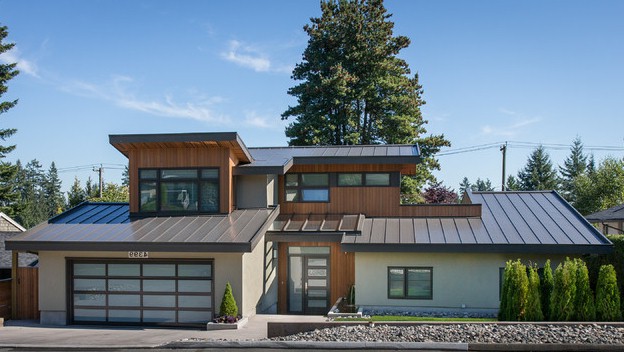A metal roof is a versatile product designed to meet a variety of building styles. It has been installed in many countries in a wide range of climate conditions. It will withstand wind forces to 120 mph. Metal can also resist damage due to freezing and thawing because of the nonporous exterior. Since it is steel, it is free from termite damage. In fact, a metal roof may be the last roof you ever need.

Benefits of metal roofing.
- Very durable in cold weather
- High percentage of recycled material and are 100% recyclable
Negatives of metal roofing.
- Rusting (require maintenance to prevent corrosion)
- Copper and lead roofs can be targeted by metal thieves
- High heat conductivity of metals (particularly copper and aluminum) requires careful incorporation of insulation into the roof structure
- Cellular and radio reception may be negatively impacted.
- During heavy rainfall they can be noisy.
Types of materials.
- Corrugated galvanized steel. This describes the original product that was wrought iron–steel sheet coated with zinc and then roll formed into corrugated sheets. This product is still used today in most areas. The newer push of modern architecture and “green” products has brought these products back to the foreground.
- Standing Seam Metal. This is a metal product that comes in rolled form and in various widths. The material is “seamed” together using a special seaming tool that is run vertically up the panel to seal the joints and prevent water intrusion.[7]
- Metal tile sheets. These are usually painted or stone-coated steel.
- Copper. Copper roofs offer corrosion resistance, durability, long life, low maintenance, radio frequency shielding, lightning protection, and sustainability benefits. Copper roofs are often one of the most architecturally distinguishable features of prominent buildings, including churches, government buildings, and universities. Today, copper is used in roofing systems, flashings and copings, rain gutters and downspouts, domes, spires, vaults, and various other architectural design elements.
- Aluminum. One of the longest-lasting metals, but somewhat expensive compared to steel products. Aluminum roofs are very lightweight, corrosion-resistant, have high natural reflectivity and even higher natural emissivity, increasing a building’s energy efficiency. Aluminum products with Kynar paints easily last over 50 years. The newest innovation is anodizing of the aluminum coil stock for use in architectural details and standing seam panels. The anodized layer is intimately bonded to the metal and is not normally subject to weathering and wear.
- Stone coated steel. Panels made from zinc/aluminium-coated steel with acrylic gel coating. The stones are usually a natural product with a colored ceramic coating.
- Lead is often used for church roofs and porches.
